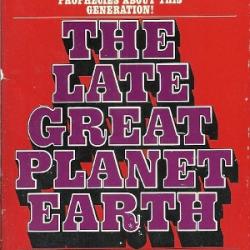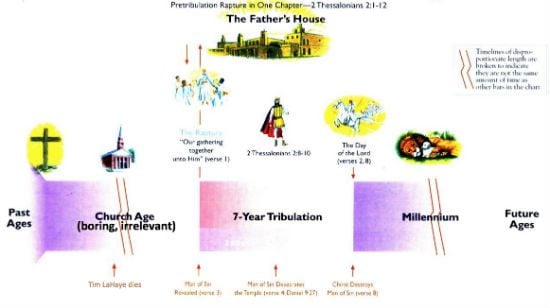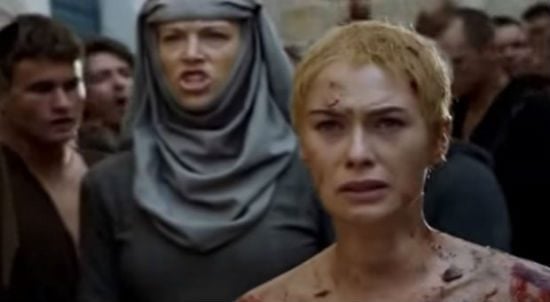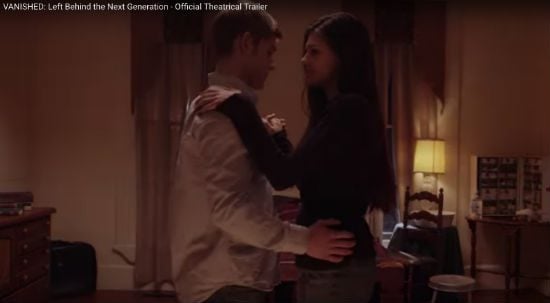I've already discussed acting more than I intended to, but we should note here that Janaya Stephens has two Big Dramatic Scenes in this slice of the movie. The first is with CamCam, the second is with Brad Johnson. The difference is instructive. Scripts matter, but who you're working with matters just as much.
Chloe and CamCam head back to the airport — a trip that seems particularly uneventful and un-post-Event-ful, particularly in light of CamCam's dire warning ("It's madness out there").
Director Vic Sarin goes back to the well one more time to show us that the loyally mournful abandoned dog on the sidewalk across the street is still there. It's hard to complain that such touches of bathos are overdone here when scenes like that were so utterly absent from the book. Sarin displays more pity for that dog than LaHaye and Jenkins had for any human in their story.
The shot of the dog is a reminder, though, not just that this poor animal still sits neglected, but that its human companion's clothes sit neglected too. Those clothes are evidence. That dog is guarding what ought to be regarded as an active crime scene. Those clothes, quite recently, were wrapped around a human body and that human has disappeared — possibly abducted, possibly murdered. Law enforcement, or at the very least the person's insurance company, has an interest in determining what exactly happened to them. The fact that this incident is not an isolated case makes this crime scene more, not less, important.
So those clothes shouldn't still be lying there. By this point they ought to have been tagged and bagged and shipped off to some (still fully staffed) lab for analysis.
Ken Ritz is holding court in an airplane hangar, auctioning off his services to the highest bidder. Working actor Neil Crone (the poor man's Richard Karn) plays him with bouyant bonhomie, but he's not quite able to backslap his way past the awful dialogue he's been given.
Here, as in the book, Ritz bears the burden of being the only curious person on the planet in the aftermath of the Event. It falls to him to run through the theories and possible explanations for what has occurred. And here, as in the book, his summary of all of this is dreadfully inadequate.
Both the novel and the movie treat the space alien theory as silly and easily dismissed. This is strange, since it's not actually far off from what they say actually happened. According to L&J themselves, the Event was, in fact, a mass-abduction by an extra-terrestrial power. Their brand of religion is so extravagantly otherworldly that they're not really in a position to mock UFO obsessives.
Ritz's litany of theories is shorter here than in the book, but in both cases it suffers from sounding too, well, theoretical. "My theory's no wackier than some of the stuff floating around out there," he says. But this concern with "wackiness" is out of place in a post-Event world. Wacky is the new reality. The world is upside-down, mystifying, inexplicable and unthinkable. Nothing at this point could strike anyone as too wacky. Any viable theory, actually, would seem to need a wackiness commensurate with the wackiness of actual events. If I were in charge, post-Event, I'd be summoning Chris Carter and the editors of the Fortean Times and the Weekly World News to serve on my blue-ribbon investigation.
We kicked around quite a few alternative theories when we discussed this passage in the novel — wormhole, timeshift, Langoliers, hostile aliens, friendly aliens, Star Trek V demigod aliens, spontaneous human combustion, spontaneous human reduction ("Honey, I shrunk all the kids"), Hiro Nakamura, Dormammu, LHC mishap, MSG/HFCS mishap, etc. — and we don't need to rehash all of that, but there's one other theory that, while inadequate, would likely be popular in the world portrayed in this movie: Blame the Jews.
In the real world, this theory is a shamefully popular perennial favorite. And it has the advantage of being popular despite never actually making any sense. Here in the movie, we've already heard refernces to the "global food supply" and to a secret Jewish formula, and that would seem like more than enough to convince those prone to believing such things that Rosenzweig's magic fertilizer was somehow responsible for the disappearances. The idea wouldn't withstand a moment's scrutiny — many who ate the Israeli wheat didn't disappear, and many who disappeared didn't eat it — but the popularity of anti-Semitic scapegoating conspiracy theories has never been constrained by the requirements of logic, fact or reason.
I'd explore this idea further but, frankly, trying to follow the recursive loops of anti-Semitic ideologies bound up in Tim LaHaye's brand of premillennial dispensationalism makes my head hurt. (In the Last Days, the enemies of God will be destroyed for trying to destroy Israel, after which God will destroy Israel. Mix in the combination of LaHaye's John Birch Society fantasies and his blanket support for any policy described as "pro-Israel" and you've got enough raw material here for someone's doctoral dissertation — in theology or in psychology or both.)
Amidst his theorizing, Ritz offers a garbled recitation of Matthew 24:40-41 — "Two men will be in the field; one will be taken and the other left. Two women will be grinding with a hand mill; one will be taken and the other left." Like LaHaye & Jenkins, he fails to notice that this is a good description of the human condition throughout the entire history of this mortal race.
As in the novel, Ritz is the first person in the movie to mention that every young child on earth has disappeared, but only some adults, and he is the first to speculate about what that might mean. He is the first to question whether or not the disappeared are "gone for good" and to wonder aloud whether more disappearances might follow. In both the movie and the book, in other words, Ken Ritz is the one person who asks what everyone ought to be asking, constantly and obsessively, until they find some answers. He is the only person in either version of this story who doesn't seem to have read the back-cover synopsis.
Crone's take on Ken Ritz also makes me realize something else that's missing in both book and movie. The Event would be devastatingly traumatic on a global scale, but despite that — or maybe because of it — there would be dozens of tasteless, heartless Event jokes circulating before the first 24 hours had passed. And Ritz is just the kind of guy who would be telling them.
The scene ends with CamCam thoughtfully pondering that, "Maybe the common factor isn't in those who were taken, maybe it's in those who were left behind," after which, sadly, he avoids walking into the propeller.
We cut to Chloe, sniffling quietly, sitting in an empty classroom. Two cheers for Sarin and the scriptwriters here. This scene wasn't in the book but it adds a great deal, making both Chloe and Rayford more human and more sympathetic.
Chloe spends most of her time in the book in her bedroom in some kind of suspended animation. Here though she does what L&J never imagined anyone in their novel would do: She goes out looking for her missing mother and brother. Her search is fruitless
and maybe even pointless, but she needed to do something. "I couldn't just sit there," she says, which rings true. In the novel, by contrast, this is exactly what everyone does — just sit there — unless and until they convert to RTC-ism.
This scene also shows us Rayford's need to keep in contact with the one member of his family still with him. That's good to see — a far more human reaction than what we saw in the book, in which Chloe somehow made her way back from Palo Alto on her own without Rayford lifting a finger. The setting — the desolate school building — is another nice reminder of the extent and impact of the Event.
The filmmakers might have made more of this scene, but it's such a welcome correction and addition to the novel that it would be churlish to say much more here than kudos for including it.
We see the New York City skyline as the redundant caption "New York" clicks onto the screen. The classroom scene that just ended closed with Rayford finding a drawing of him that Raymie had done. He snatches it off the bulletin board and looks at it with grief and sorrow and the pangs of loss. One feels something like the same thing now looking at that ca. 2000 skyline.
CamCam has arrived safely in New York, thus sparing us several chapters of travel logistics from the novel. CamCam knocks on the door of Dirk Burton's apartment, which has clearly, in movie shorthand, been Ransacked by someone Looking for Something.
Everything about this is wrong.
First of all, what is CamCam doing here at Dirk's apartment? Either he has decided, as a reporter, to completely ignore the Event as insufficiently newsworthy — and he has thus lied to Chloe when he promised her he would find "answers" in New York — or else he has made the unsupported leap that the Event must be connected to the things Dirk babbled to him about earlier in the film. If the latter, then CamCam must here be working on the theory that the Event is tied up with Dirk's conspiracy theories involving Israeli missile defense, international bankers and Rosenzweig's formula. It seems, in other words, that CamCam's initial theory in response to the Event really is to Blame the Jews.
I also don't believe that Dirk Burton would live here. It's way too windowed, uncluttered and airy a place with far too few locks on the door. I can't picture Frohike or Byers or Langly living anywhere like this. It's also huge — nearly the size of the Steele's suburban home. How does a guy like Dirk, a man with no discernible source of income, afford a Manhattan mansion?
CamCam finds Dirk lying dead upstairs from no apparent cause. This is, as we discussed at this point in the novel, inexcusably shoddy work by the grand conspiracy. Two billion people have just disappeared with hundreds of thousands more killed in the aftermath. Yet instead of taking advantage of this chaos to dispose of Burton in a way that wouldn't draw suspicion, they leave his body in a ransacked apartment (bodies, being rare at this point, are screamingly conspicuous) and may as well have left a note saying, "This man was killed because he Knew Too Much. Sincerely, The Conspiracy."
CamCam grabs Dirk's secret wrist-watch decoder ring and then suddenly we see that he is being watched through the windows by a black-clad assassin armed with the standard-issue conspirator's high-tech nightvision-scope rifle.
CamCam sits down at Dirk's computer and … no, wrong, uh-uh. There is no way that Dirk Burton, professional paranoiac, would have his desk set up like this — his back to the window, his computer screen in full view of black-clad men with telescopic sights on adjoining rooftops.
Just as Buck begins to examine the e-mail Dirk sent to Alan Tompkins (Scotland Yard, Special Anti-Global Conspiracy Flying Squad), the gunman shoots out the computer's monitor and, for good measure, a flower vase. The gunman then grins a satisfied smile, confident that Buck has been prevented from learning Dirk's dark secrets.
Unless, that is, he can somehow manage to find a replacement monitor for Dirk's hard drive.
It was dark in New York City, but it's light out again as we cut back to the Chicago suburbs. Does this mean another day has passed in our story? Possibly. Possibly not.
Rayford Steele sits in his car outside of New Hope Village Church. Except this is not what New Hope Village Church should look like. The architecture is all wrong. This is an older downtown church, not an exurban evangelical place of worship. NHVC should look like a corporate office park with a stylized steeple — and it should be surrounded by acres of parking lot, not abutting a busy street full of pedestrians.
The inside is all wrong too. It looks like a church — not at all like the kind of auditorium constructed according to the principles laid out by church-growth specialists and mega-church consultants for creating a family friendly and seeker-friendly worship space. The front wall is a stained-glass arch, for goodness sake — where are you supposed to project the PowerPoint slides with the words for the worship choruses?
We'll get back to New Hope Village Church and the final minute of this section of the movie on Friday because Clarence Gilyard Jr. deserves not to be an afterthought here. Gilyard — aka, Jimmy from Walker, Texas Ranger — shows us Bruce Barnes' remorse here in a way the book never did. For just a moment, he made me forget I was watching a Very Bad movie based on an Even Worse book.












